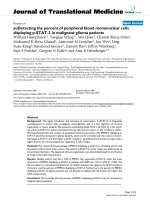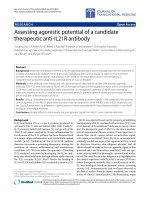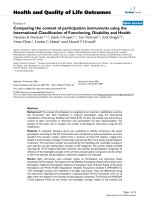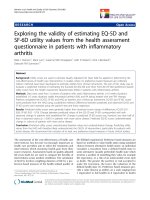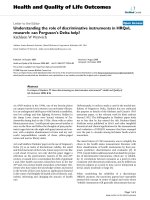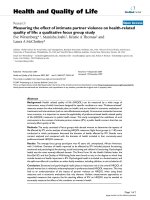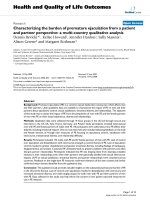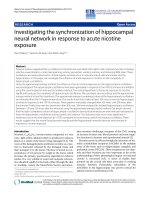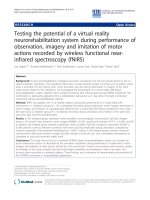Báo cáo hóa học: " Testing the potential of a virtual reality neurorehabilitation system during performance of observation, imagery and imitation of motor actions recorded by wireless functional nearinfrared spectroscopy (fNIRS)" potx
Bạn đang xem bản rút gọn của tài liệu. Xem và tải ngay bản đầy đủ của tài liệu tại đây (1.54 MB, 13 trang )
RESEARC H Open Access
Testing the potential of a virtual reality
neurorehabilitation system during performance of
observation, imagery and imitation of motor
actions recorded by wireless functional near-
infrared spectroscopy (fNIRS)
Lisa Holper
1,2*
, Thomas Muehlemann
1,3
, Felix Scholkmann
1
, Kynan Eng
2
, Daniel Kiper
2
, Martin Wolf
1
Abstract
Background: Several neurorehabilitation strategies have been introduced over the last decade based on the so-
called simulation hypothesis. This hypothesis states that a neural network located in primary and secondary motor
areas is activated not only during overt motor execution, but also during observation or imagery of the same
motor action. Based on this hypothesis, we investigated the combination of a virtual reality (VR) based
neurorehabilitation system together with a wireless functional near infrared spectroscopy (fNIRS) instrument. This
combination is particularly appealing from a rehabilitation perspective as it may allow minimally constrained
monitoring during neurorehabilitative training.
Methods: fNIRS was applied over F3 of healthy subjects during task performance in a virtual reality (VR)
environment: 1) ‘unilateral’ group (N = 15), contralateral recording during observation, motor imagery, observation &
motor imagery, and imitation of a grasping task perfo rmed by a virtual limb (first-person perspective view) using
the right hand; 2) ‘bilateral’ group (N = 8), bilateral recording during observation and imitation of the same task
using the right and left hand alternately.
Results: In the unilateral group, significant within-co ndition oxy-hemoglobin concentration Δ[O
2
Hb] changes
(mean ± SD μmol/l) were found for motor imagery (0.0868 ± 0.5201 μmol/l) and imitation (0.1715 ± 0.4567 μmol/l).
In addition, the bilateral group showed a significant within-condition Δ[O
2
Hb] change for observation (0.0924 ±
0.3369 μmol/l) as well as between-conditions with lower Δ[O
2
Hb] amplitudes durin g observation compared to
imitation, especially in the ipsilateral hemisphere (p < 0.001). Further, in the bilateral group, imitation using the
non-dominant (left) hand resulted in larger Δ[O
2
Hb] changes in both the ipsi- and contralateral hemispheres as
compared to using the dominant (right) hand.
Conclusions: This study shows that our combined VR-fNIRS based neurorehabilitation system can activate the
action-observation system as described by the simulation hypothesis during performance of observation, motor
imagery and imitation of hand actions elicited by a VR envi ronment. Further, in accordance with previous studies,
the findings of this study revealed that both inter-subject variability and handedness need to be taken into
account when recording in untrained subjects. These findings are of relevance for demonstrating the potential of
the VR-fNIRS instrument in neurofeedback applications.
* Correspondence:
1
Biomedical Optics Research Laboratory (BORL), Division of Neonatology,
Department of Obstetrics and Gynecology, University Hospital Zurich,
Frauenklinikstrasse 10, 8091 Zurich, Switzerland
Full list of author information is available at the end of the article
Holper et al. Journal of NeuroEngineering and Rehabilitation 2010, 7:57
/>JNER
JOURNAL OF NEUROENGINEERING
AND REHABILITATION
© 2010 Holper et al; licensee BioMed Central Ltd. This is an Open Access article distributed under the terms of t he Creative Commons
Attribution License ( which permits unrestricted use, distribution, and reproduction in
any medium, provided the original work is properly cited.
Introduction
Neurorehabilitation based on the simulation hypothesis
Over the last decades, promis ing strategies in neuroreh-
abilitation, e.g. following cerebral stroke [1-3], have been
intro duced based on the so-called simulation hypothesis
[4,5]. The hypothesis suggests that the neural networks
of a action-observation system located in the primary
motor cortex (M1) and secondary motor areas, such as
premotor cortex (PMC), supplementary motor area
(SMA) and the parietal cortices, are not only activated
during overt motor execution, but also during observa-
tion or imagery of the same motor a ction [6]. These
networks are activated when individuals learn motor
actions via execution (as in traditional motor learning),
imitation, observation (as in observational learning) and
motor imagery. Activation of these brain areas following
observation or motor imagery may thereby facilitate
subsequent movement execution by directly matching
the observed or imagined action onto th e internal simu-
lation of that action [7]. It is therefore believed that this
multi-sensory action-observation system enables indivi-
duals to (re)lea rn impaired motor functions through the
activation of these internal action-related representa-
tions [8].
We have integrated this knowledge in a novel neuror-
ehabilitativ e treatment system, based on motor and ima-
gery performance in a virtual reality (VR) environment
[9]: the system consists of a VR environment containing
virtual representations of the patient’s own arms and
hands, which are displayed on a large screen and con-
trolled by the patient wearing arm position trackers and
data gloves. To activate the action-observation system,
patients can train impaired upper limb function by play-
ing interactive games in which they have to perform or
imagine specific upper limb movements to interact with
the VR environment. By adjustably mapping the move-
ments of both the paretic and healthy limb onto the vir-
tual limbs, the system offers individual training of upper
limb motor function even in patients with little arm or
hand movement ability.
Functional near-infrared spectroscopy
To monitor the VR system’s effects on brain activation,
we chose functional near-infrared spectrosco py (fNIRS).
fNIRS is a non-invasive technique based on neurovascu-
lar coupling, which exploits the effect of metabolic activ-
ity due to neural processing on the oxygenation of
cerebral tissue. Utilizing this tight coupling bet ween
neuronal activity and localized cerebral blood flow,
fNIRS measures hemodynami c changes associ ated with
cortical activation [10]. Optical NIR technology has
been shown to be a reliable tool for functional neuroi-
maging of the human brain [11]. Although NIR
technologies feature lower spatial resolution and are
only able to image cortical tissue while not providing
deeper tissue interrogation as compared to traditional
neuroimaging methods such as functional magnetic
resonance imaging (fMRI), they offer the advantage of
portable systems and, in theory, insensitivity to electro-
magnetic fields and ferromagnetic materials. In this
study a novel miniaturized wireless fNIRS instrument
was used [12]. This wireless and portable NIRS technol-
ogy does not require t he subject’s body or head to be
restrained, and therefore represents an optimal brain
monitoring tool for our purpose to record from subjects
performing movements in a VR environment. It is
thought that this wireless fNIRS technology cou ld over-
come some of the limitations inherent to traditional
neuroimaging methods.
While the action-observation syst em described above
has been widely investigated using traditional neuroima-
ging methods [13-15], so far there are only a few studies
using NIRS based techniques [16-19]. Further studies
have shown fNIRS to be a reliable tool to measure brain
oxygenation related to motor imagery performance
[20-27], confirming the well-known cortical areas
located in primary and secondary motor areas.
The focus of the present study was to obtain evidence
of the VR system’ s efficacy in neurorehabilitation by
evaluating its effects on brain activation. In particular,
we aimed 1) to provide evidence, that our VR system is
able to elicit the action-observatio n system and 2) to
draw conclusions for the system’s further application in
neurorehabilitative treatment. We hypothesized that the
observation, imagery and imitation of a hand motor task
in an interactive VR environment enhances the related
cortical oxygenation changes of the action-observation
system as measured by fNIRS. The long-term aim is to
implement the data obtained in the development of a
VR-fNIRS based brain computer interfaces (BCIs). Such
a V R-fNIRS based BCI could enhance patients’ mot iva-
tion by providing real-time neurofeedback thereb y
allowing therapists to record pre-post treatment pro-
gress assessing training-induced oxygenation changes.
Materials and methods
Subjects
Right-handed subjects were recruited via advertisements
at the University of Zurich and ETH Zurich. Exclusion
criteria w ere any history of visual, neurological or psy-
chiatric disorders or any current medication. All sub-
jects gave informed consent. All subjects had normal or
corrected-to-normal vision. The study was approved by
the ethics committee of the Canton of Zurich and was
in accordance with the latest version of the Helsinki
declaration.
Holper et al. Journal of NeuroEngineering and Rehabilitation 2010, 7:57
/>Page 2 of 13
Experimental protocol
Prior to r ecording, subjects completed the Edinburgh
Handedness Inventory (EHI) [28] assessing hand domi-
nance to exclud e left-handed subj ects. The right-handed
subjects were assigned to one of two groups: either to
the ‘unilateral’ group (N = 15) or to the ‘bilateral’ group
(N = 8). Each subject in either group participated in one
experimental session. However, bilateral wireless NIRS
measurements are more d emanding with respect to the
instrumentation: two devices are needed instead of one
and they must be time-synchronized.
All experiments were conducted in a quiet room. Sub-
jects sat in front of a custom made VR table-system
with a computer screen (94 cm diagonal) to display the
VR environment [9]. The subjects were asked to place
their hands on the table with the palms facing down-
wards, and faced the monitor at a distance of approxi-
mately 70 cm. The image on the monitor showed a
virtual arm in the same orientati on and relative position
as the real arms, resting on a flat surface representing
the table. The close corres pondence between the virtual
and real arms in terms of position and relative (first-
person) orientatio n was designed to optimally stimulate
the patient to imagine the virtual arms as their own dur-
ing the experimental session.
Unilateral group
In the subject group ‘ unilateral ’ , fNIRS was recorded
overthelefthemispherewhilethesubjectperformed
the VR tasks under four conditions:
▪ ‘Observ ation (O)’: subjects passively watched a VR
video which displayed a right upper limb with the
hand repeatedly grasping an incoming ball (13
actions, approx. 0.86 Hz) (Figure 1).
▪ ‘Observation & motor imagery (O&MI)’:sameas
condition O, except that subjects were asked to ima-
gine that the virtual arm was their own.
▪ ‘Motor imagery (MI)’: same as condition O&MI,
but without visual input - subjects had to imagine
performing the action.
▪ ‘Imitation (IM)’: subjects imitated the hand move-
ments performed in the VR task by the virtual arm
while watching the VR video.
The session began with a practice trial (approx. 5 min)
to allow subjects to become familiar with the tasks.
After the practice trial, all subjects first performed con-
dition O followed by a randomized presentation of con-
ditions O&MI, MI and IM (Easy Randomizer, Version
4.1. [29]). Subjects were reminded to perform the exe-
cuted or imagined movements with the same frequency
as shown in the video (approx. 0.86 Hz). Each condition
lasted530s(8min50s)consistingof10trialseach
comprising an initial rest period (30 s), followed by 10
stimulation periods (20 s) alternated with rest periods
(30 s) (Figure 2). The total number of trials per subject
was 40; the total duration of the experiment was approx.
35 min per subject. We chose these irregular periodic
alternations of 20 s stimulation and 30 s rest periods to
avoid the induction of s ynchronization of the sequence
of the motor stimulation/re st periods in the motor sti-
mulation protocol with systemic rhythms such as heart-
beat, respiration and heart rate fluctuations.
Bilateral group
The subject group ‘bilateral’ had the same VR task as
the group ‘unilateral’, but was recorded bilaterally. This
group was included to test for a lateralized distribution
of oxygenation p atterns for the ipsi- and contralateral
side, as seen in related studies [30-33]. We hypothesized
that, on the one side, the hemisphere contralateral to
the hand performing the task would show larger [O
2
Hb]
changes as compared to t he ipsilateral hemisphere. The
detection of larger [O
2
Hb] changes over the hemisphere
contralateral would provide evidence that we were
indeed recording from the correct position, i.e. covering
motor-related cortical areas. Conditions O and MI were
chosen as we assumed that these conditions would elicit
the s mallest oxygenation changes, both unilaterally and
bilaterally. Therefore conditions O&MI and MI were
dropped as we assumed that these conditions would fol-
low a similar pattern to the other conditions.
▪ ‘Observati on right (O_R)’: Same as condition O in
the unilateral group.
▪ ‘Observation left (O_L)’ :SameasconditionO_R,
except that a left hand was shown in the VR video.
▪ ‘Imitation right (IM_R)’: Same as condition IM in
the unilateral group.
▪ ‘Imitation left (IM_L)’:SameasconditionIM_R,
except that a left hand was shown in the VR video
Figure 1 Ball catching task (13 actions in 20 s) as shown in the
VR video (from top left to bottom right).
Holper et al. Journal of NeuroEngineering and Rehabilitation 2010, 7:57
/>Page 3 of 13
and subjects were asked to imitate the movement
with their left hand.
After the practice trial, all subjects performed condi-
tion O_R or O_L first, which was randomly assigned,
followed by condition IM_R or IM_L, which was also
randomized (Easy Randomizer, Version 4.1. by [29]).
The procedure and timing were the same for both the
‘unilateral’ and the ‘bilateral’ groups.
NIRS instrumentation
The novel miniaturized continuous wave wireless fNIRS
sensor has been previously described in detail [12]. The
optical a nd electronic components are mounted onto a
four-layer rigid-flexible printed circuit board ( PCB)
which, in combinatio n with a highly flexible casing
made of medical grade silicone, enables the sensor to be
aligned to curved body surfaces such as the head. The
sizeofthedeviceis92×40×22mmandweighs40g.
The optical system comprises fo ur light sources at two
different wavelengths (760 nm and 870 nm) and four
detectors (PIN silicon photo diodes). The distance
between light sources and detectors is 25 mm, four light
source-detector pairs are linearly arranged every 12.5
mm and thus cover an area of 37.5 × 25 mm (Figure 3).
Each light source consists of two pairs of serially con-
nected light emitt ing diodes (LE D) is drive n using cur-
rent control and is time multiplexe d with an on-time of
120 μs per sample and a forward voltage of 4 V per
diode. Although LEDs have a broader emission spec-
trum than lasers, they have several advantages: they can
be applied directly on the body surface without need for
lenses or fibers and they are inexpensive. Furthermore,
they are harmless for the eye, which is an important
advantage in a clinical en vironment. The power is pro-
vided by a rechargeable battery, which allows continu-
ous data acquisition for 180 minutes at full light
emission power. The light intensity is sampled at
100 Hz and the resulting data are transmitted wirelessly
to the host computer by Blueto oth. The operating range
of the sensor is about 5 m. The wireless sensor has been
found to be capable of detecting both localized changes
[O
2
Hb]and[HHb]intheadultbrainandoxygenation
changes of muscular tissue [12,34].
For fNIRS recording, the sensor(s) was(were) placed
either contralateral (unilateral group) or bilaterally
(bilateral group) on the subject’s head presumably cov-
ering F3 according to t he international 10-20 system
[35]. With the compact sensor of 37.5 mm length and
25 mm width, we assumed t hat we covered secondary
motor areas [36]. Hairs under the sensor(s) were care-
fully brushed away before fixation; shaving was not
required. The sensor was fixed on the subject’ s head
using medical-grade, disposable, self-adhesive bandages
(Derma Plast CoFix 40 mm, IV F Hartmann, Neuhausen,
Switzerland).
For final data processing, by measuring intensity of
NIR light after its transmission trough tis sue, it is possi-
ble to determine changes over time in the concentration
of oxy-hemoglobin (O
2
Hb) and deoxy-hemoglobin
(HHb), which represent the d ominant light absorbers
for living tissue in the NIR spectral band. By applying
Figure 2 Experimental block design. Each condition consisted of an initial rest period of 30 s, followed by 10 stimulation periods
(20 s) alternated with rest periods (30 s). Each condition lasted 530 s (8 min 50 s); the total duration of the experiment was approx. 35 min
per subject.
Holper et al. Journal of NeuroEngineering and Rehabilitation 2010, 7:57
/>Page 4 of 13
the modified Beer-Lambert law (MBBL), the concentra-
tion for O
2
Hb and HHb ([O
2
Hb], [HHb]) were com-
puted from the measured absorption changes [37,38].
A MATLAB® (Version 2008a) program was applied to
pre-process the raw light intensity values and to com-
pute [O
2
Hb] and [HHb] changes. The measurement
files that were acquired durin g the fNIRS experiment
contain the intensity sign als of the NIR light, sampled at
100 Hz for all combinations of light-sources, wave-
lengths and detectors, as well as the intensity of the
ambient light. The program subtracts the ambient light
intensities from the NIRS measurement values before
low-pass filtering (7
th
order Chebyshew with 20 dB
attenuation at 5 Hz) and decimating the signals to a
sampling rate of 10 Hz. Consecutively, the MBLL is
used to compute the changes of [O
2
Hb] and [HHb]
applying differential path lengths factors (DPF) of 6.75
for the 760 nm and 6.50 for the 870 nm light-sources
[39]. The [O
2
Hb] and [HHb] signals acquired w ith the
wireless NIRS signal characteristically drift slightly over
time, which can mostly be attributed to thermal effects.
Therefore, data was recorded only two minutes after
starting the fNIRS sensor, allowing the setup to reach
thermal equilibrium. The remaining signal drift [12] was
highly linear as assessed by visual inspection and thus
their linear least squares approximation was subtracted
from [O
2
Hb] and [HHb] for drift elimination.
Data Analysis
Descriptive anal ysis was calculated for a ll med ian signa l
amplitudes (μmol/l ± SD). Each source-detector combi-
nation (channel) and each condition was averaged to
attempt to provide a detectable signal. The crite rion for a
detectable signal was the relat ive value between stimula-
tion and baseline, i.e. increase in [O
2
Hb] and decrease in
[HHb]. At this point those channels that did not show
task related oxygenation changes were excluded from
further analysis, since it was assumed that those channels
did not cover the activated cerebral region at all. For the
same reason, subjects that did not display statistically sig-
nificant changes of the [O
2
Hb] median for the condition
IM (control condition) were excluded as well.
All data were positively tested for Gaussian distribution
using the Kolmogorov-Smirnov test. Consecutively,
dependant variables fo r further statistical analysis were
derived from the non-excluded [O
2
Hb] and [HHb] data-
sets. Specifically, the median of the last 10 s of the stimu-
lation periods ([HHb]
stim
,[O
2
Hb]
stim
, stimulation
amplitudes) and the median o f the last 10 s of the rest
periods ([HHb]
rest
,[O
2
Hb]
rest
, baselines) were tested in
Figure 3 Top-view: schematic of light sources (L1, L2, L3, and L4) and detectors (D1, D2, D3, and D4) on the sensor. The center of the
sensor was positioned over position F3 according to the 10-20 system. Four channels were considered for analysis. D1-L1 were in cranial
direction, D4-L4 were in caudal direction.
Holper et al. Journal of NeuroEngineering and Rehabilitation 2010, 7:57
/>Page 5 of 13
the analysis. The median was chosen instead of the mean
as it is more robust to outliners that may have statistically
unbalanced the analysis in our relatively small subject
sample. The statistical significance of the intra-condition
differences between ([HHb]
rest
,[O
2
Hb]
rest
) and ([HHb]
stim
,[O
2
Hb]
stim
), later referred to as Δ[HHb] and Δ
[O
2
Hb], was analyzed using the paired t-test.
The statistical significance of inter-conditional differ-
ences of [O
2
Hb]
stim
and [HHb]
stim
as well as for [HHb]
rest
and [O
2
Hb]
rest
were first assessed across all condi-
tions. Then, if a significant difference was found, it was
followed by a pair wise comparisons for all possible con-
diti on pairs using one-way ANOVA; the alpha-value for
significance was set to ≤ 0.05 and the Bonferroni correc-
tion was applied to eliminate the problem of multiple
comparisons.
Results
Behavioral data
23 healthy subjects were included in the analysis (15
unilateral group, 8 bilateral group, 9 males, mean age
26 years, range 22 - 33 years). Five subjects (2 in unilat-
eral group; 3 in bilateral group) were excluded from
analysis due t o a missing signal in the IM conditio n. All
subjects were right-handed according to the EHI with a
mean LQ of 81.9 (range 73 - 100) and a mean deciles
level of 6.1 (range 3 - 10).
fNIRS measurements
Unilateral group
The mean Δ[O
2
Hb] (Table 1) was largest in the IM con-
dition,followedbyMI,O,andO&MI.MeanΔ[HHb]
was largest in condition MI, followed by IM, O&MI,
and O. The data showed a higher degree of inter-subject
variability observed for Δ[O
2
Hb] compared to Δ[HHb]
as calculated by the standard deviation (SD) of the oxy-
genation changes.
Intra-condition analysis of the median changes
between [O
2
Hb]
rest
and [O
2
Hb]
stim
using a paired t-test
(Table 1) revealed statistical significance in the MI (p =
0.049) and IM (p < 0.001) conditions. No significant dif-
ferences were detected between [HHb]
rest
and [HHb]
stim
.Figure4showsanexampleofasamplesubjectof
the oxygenation changes from rest to stimulation period
in each of the four conditions.
Inter-condition analysis of the mean amplitude
changes of Δ[O
2
Hb] and Δ[HHb] betwee n rest and sti-
mulation periods between the four conditions using
one-way ANOVA (Table 1, Figure 5) revealed neither a
main effect of condition, nor statistical significant
between the four conditions.
Bilateral group
In this group a smaller number of subjects was included,
although sufficient to reach statistical significance.
In the left hemisphere, the mean Δ[O
2
Hb] (Table 2 )
were largest in condition IM_L, followed by IM_right,
O_R, and O_L. Mean Δ[HHb] were largest in condition
IM_L, followed by IM_R, O_L and O_R.
On the right hemisphere, mean Δ[O
2
Hb] were largest
in condition IM_L, followed by IM_R, O_R, and O_L.
Mean Δ[HHb] were largest in condition IM_L, followed
by IM_R, O_L and O_R. As also seen in the unilateral
group a relatively high inter-subject variability was
observed, as documented by the standard deviation (SD).
Intra-condition analysis (left hemisphere (LH), right
hemisphere (RH)) of the median change between [O
2
Hb]
rest
and [O
2
Hb]
stim
using the paired t-test (Table 2)
revealed statistical significant differe nces in conditions
O_R (LH p = 0.016, RH p = 0.006), O_L (LH p = 0.046,
RH p = 0.025), I M_R (LH p = 0.003, RH p < 0.001) and
IM_L (LH p < 0.001, RH p = 0.001). Between [HHb]
rest
and [HHb]
stim
statistical significance was observed in
condition IM_L (LH p = 0.040, RH p < 0.001).
Inter-condition analysis of the mean amplitude
changes of Δ[O
2
Hb] and Δ[HHb] between the four con-
ditions using one-way ANOVA (Table 2, Figure 6)
revealed a main effect of condition for [O
2
Hb](LHp=
0.028, RH p < 0.001) and for [HHb] (RH p < 0.001). Sta-
tistical significance was found for Δ[O
2
Hb] between-
conditions O_R and IM_L (RH p < 0.001), O_L and
IM_L (RH p = < 0.001) and IM_R and IM_L (RH p <
0.001); analog for Δ[HHb] betwe en-conditions O_R and
IM_L (RH p < 0.001), O_L and IM_L (RH p = < 0.001)
and IM_R and IM_L (RH p < 0.001).
In the following discussion we concentrate on the
observed [O
2
Hb] changes, since this parameter shows
the relevant significant oxygenation changes, whereas
[HHb] did show overall significant levels. This is sup-
ported by previous fNIRS work suggesting that interpre-
tations about task-relevant activation increases are
usually attributed to the prominent increases in [O
2
Hb]
[40], whereas [HHb] is often not reported.
Discussion
Virtual reality based neurorehabilitation
Recent experimental evidence suggests that rapid
advancement of VR technologies has great potential for
the development of novel strategies for sensory-motor
training in neurorehabilitation [41]. The combination
with our wireless and portable fNIRS brain monitoring
technique [12] is particularly appealing from a rehabili-
tation perspective as it allows therapists and patients
unconstraint monitoring while testing and training
motor performance [21,42].
In this study we provide evidence for the efficacy of our
new VR neurorehabilitation system [9] by evaluating its
effects on brain activation. In particular, we show that
our VR system is able to elicit the action-observation
Holper et al. Journal of NeuroEngineering and Rehabilitation 2010, 7:57
/>Page 6 of 13
system as described by the simulation hypothesis. Based
on these results we aim in the long-term to develop a
VR-fNIRS based BCI that providing the possibility of
real-time neurofeed back combined with an assessment of
training-induced cortical oxygenation changes.
Observation, imagery and imitation
From the comparisons between stimulation and rest peri-
ods, our result s confirm the simulation hypothesis in
accordance with well-known findings in fMRI and EEG
[3,14,15,43,44] and previous fNIRS studies [21-25,45]
that have shown that oxygenation changes can be found
within the same s econdary mo tor areas dur ing observa-
tion, motor imagery and overt motor execution (unilat-
eral and bilateral group, Figure 5 and 6). Although not all
of the observed changes reached statistical significance,
our results revealed that averaged Δ[O
2
Hb] during obser-
vation and motor imagery were approx imately one-third
lower compared to the imitation task. This result is in
line with the previous studies mentioned above where
both imagery and observation have been reported to eli-
cit consistently lower oxygenation changes.
Inter-subject variability
We observed a high inter-subject variability in Δ[O
2
Hb]
in both our samples. General reasons for variability
between individuals may be effects of anatomical var-
iance such as thickness of the skull or cerebrospinal
fluid layers [46,47]. Another contributing factor might
be that our subjects had no prior specific experience in
the tasks presented. They we re not specifically trained
to perform the tasks prior to the experiment (but only
received a short practice trial), yet this has been done in
a previous fNIRS controlled BCI [24]. Therefore, in our
untrained subjects, inter-subject variability in the h emo-
dynamic response patterns might have be en higher than
it would h ave been after substantial pre-experimental
training. The question of the extent to which a person
is able to generate a mental representation of move-
ments is even more relevant in the assessment of indivi-
duals following brain injury. Lesions involving specific
cortical areas may impair certain imagery abilities [48],
such as overall slowing of imagery processes resulting in
modified temporal characteristics of motor imagery
[49,50].
Bilateral oxygenation
As observed in previous studies, brain activation in
response to executed or imagined actions can differ
depending on the hemisp here recorded [51 -53]. In gen-
eral, unimanual tasks show hemispheric asymmetry with
predominant activation of the contralateral hemisphere
controlling the moving hand, as assessed by fMRI and
PET [30-33]. Additionally, ipsilateral activation is both
foundinM1andshiftedlaterally, ventrally, and ante-
riorly towards PMC for unimanual tasks with respect to
that observed during contralateral hand movements
[54-60]. Accordingly, we observed ipsi- and contralateral
oxygenation changes, both during observation and
imitation.
Table 1 Unilateral group
Unilateral group [N = 15] Observation Motor imagery Observation & motor imagery Imitation
left hemisphere (contralateral) (μmol/l ± SD)
Mean Δ[O
2
Hb] 0.0692 ± 0.4510 0.0868 ± 0.5201 0.0446 ± 0.5741 0.1715 ± 0.4567
Mean Δ[HHb] -0.0052 ± 0.1247 0.0356 ± 0.2043 -0.0089 ± 0.2391 0.0212 ± 0.1685
T-test, CI 95%
[O
2
Hb] p = value p = 0.154 p = 0.049* p = 0.333 p < 0.001*
[HHb] p-value p = 0.161 p = 0.061 p = 0.760 p = 0.323
ANOVA, post-hoc-tests, Bonferroni 0.05 [HHb] p-value [O
2
Hb] p = value
O - MI p = 0.387 p = 1.000
O - O&MI p = 1.000 p = 1.000
O - IM p = 1.000 p = 0.509
MI - O&MI p = 0.265 p = 1.000
MI - IM p = 1.000 p = 0.934
O&MI - IM p = 1.000 p = 0.194
(Top) Mean signal amplitudes (μmol/l ± SD) of channels with significant concentration changes. Separate calculations for increases in [O2Hb], decreases in [HHb]
in response to the four conditions for each group. Numbers were rounded to four decimal places. (Middle) Intra-condition statistical significance of the mean
changes be tween [O2Hb]rest and [O2Hb]stim and [HHb]rest and [HHb]stim using the paired t-test; confidence interval (CI) = 95%. (Bottom) Inter-condition
statistical significance of mean changes of Δ[O2Hb] and Δ[HHb] between the four conditions using ANOVA. Shown are post-hoc tests (with Bonferroni correction);
significant values (p ≤ 0.05) are highlighted by * (observation = O, motor imagery = MI, observation & motor imagery = O & MI, imitation = IM)
Holper et al. Journal of NeuroEngineering and Rehabilitation 2010, 7:57
/>Page 7 of 13
Thedifferenceobservedbetween the unilateral and
the bilateral group is concerned about the aspect of
handedness. Interestingly, we found that performance
during the condition IM_ L (imitation with the subject’s
left non-dominant ha nd) revealed larger Δ[O
2
Hb] in
both hemispheres as compared to IM_R (imitation with
the subject’s right dominant hand) (Figure 6). Further,
the Δ[O
2
Hb] in the right h emisphere during movement
of the subjects’ left hand (i.e. the non-dominant, contral-
ateral hand) is considerably larger than that in the left
hemisphere during ipsilateral movement. Additionally,
in the left hemisphere during ipsilateral movement
(non-dominant hand) the Δ [O
2
Hb] was larger than that
observed during contralateral movement (dominant
hand; according to the unilateral group). Figure 5 and 6
reflect these findings showing the observed inter-condi-
tion differences in the right hemisphere including lower
level Δ[O
2
Hb] amplitude during o bservation as com-
pared to imitation (Figure 6). These findings might be
explained by the hand dominance of our right-handed
sample. Previous fMRI studies described that non-domi-
nant hand movements appear to require more cortical
activity and therefore may result in greater recruitment
of ipsi- and contralateral cortical moto r areas [61],
Figure 4 Example of a sample subject of the oxygenati on changes Δ[O
2
Hb] and Δ[HHb] (μmol/l) from rest (30 s) to stimulation (20 s)
period in each of the four conditions Observation (O), Imagery (MI), Observation & Imagery (O&MI) and Imitation (IM). Stimulation on-
and offset is indicated by the dotted lines.
Holper et al. Journal of NeuroEngineering and Rehabilitation 2010, 7:57
/>Page 8 of 13
perhaps because they are less ‘automatic’.Ithasbeen
further observed that this ips ilateral activation was most
pronounced in pre-central areas (presumably corre-
sponding to secondary motor areas) during both domi-
nant and non-dominant performance [62]. However,
further fNIRS studies are needed to confirm whether or
not our findings of larger Δ[O
2
Hb] during non-domi-
nant performance are in fact ca used by the right-hand-
edness of our sample.
Neurorehabilitative potential of combined VR NIRS
applications
Taken togeth er the findings of the uni- and bilateral
groups, the results show that our VR system ca n activate
the action-observation system as described by the simula-
tion hypothesis. I n particular, 1) the study provides evi-
dence that fNIRS recording does not impede interaction
with the VR environment This point is an important pre-
condition for further development of combined VR-fNIRS
based applications for use in neurorehabilitation. It
increases usability in that it requires a short time to fit
fNIRS sensor important for therapy. Further, the results
revealed two factors that need to be taken into account
when dealing with fNIRS signals aimed to provide a basis
for neural interfaces: 2) The inter-sub ject variability is
obvious at the group level and will be even more promi-
nent at he single subject lev el. The reasons for inter-
subject variability, i.e. individual experience in motor
imagery performance, physiological and anatomical differ-
ences, require further assessment. 3) The combined factors
of recording side, i.e. uni- or bilateral hemispheres, as well
as hand side, i.e. left or right hand used during motor or
imagery tasks, need to be taken into account. Our findings
may reflect an aspect of hand edness in right-handed sub-
jects who may require more cortical activity w hen using
the non-dominant hand. Future studies may include both
left-handers and right-handers. Considering these factors
may contribute to differentiation of individual oxygenation
pattern and permit classification of activatio n tasks used
for neurofeedback or BCI applications.
Figure 5 Unilateral group recorded over left hemisphere: diagram of the Δ[O
2
Hb] amplitude changes with standard error of the mean
(SEM) and statistical significances of paired t-test are shown.
Holper et al. Journal of NeuroEngineering and Rehabilitation 2010, 7:57
/>Page 9 of 13
Study limitations
Although the present study revealed interesting results
concerning the potential of the new wireless NIRS sys-
tem, it was subject to some known limitations. We did
not record an electromyogram (EMG) in order to
exclude the presence of muscular activation during
observation and motor imagery. It could be claimed that
weak motor activity might have been present during the
imagery tasks. However, previous neuroimaging studies
suggested that brain signals during imagery of hand
motor tasks are not correlated with EMG activity [63].
Another possible limitation is that we r eferenced the
positioning of the NIRS device according to the 10-20
system [35]. However, this positio ning may be inac cu-
rate due to inter-subject variability in anatomical head
size and shape, and the location on underlying (pre-)
motor areas. The location of NIRS recording can there-
fore generally only be assumed to have correctly covered
the preferred areas, i.e. in our case secondary motor
areas.
Table 2 Bilateral group
Bilateral group [N = 8] Observation right Observation left Imitation right Imitation left
Left hemisphere (μmol/l ± SD)
Mean Δ[O
2
Hb] 0.0924 ± 0.3369 0.0835 ± 0.4589 0.1905 ± 0.5515 0.2712 ± 0.4424
Mean Δ[HHb] -0.0028 ± 0.1039 -0.0138 ± 0.1923 0.0206 ± 0.1569 0.0297 ± 0.1273
T-test, CI 95%
[O
2
Hb] p = value p = 0.016* p = 0.046* p = 0.003* p < 0.001*
[HHb] p-value p = 0.807 p = 0.523 p = 0.244 p = 0.040*
ANOVA, post-hoc-tests, Bonferroni 0.05 [HHb] p-value [O
2
Hb] p = value
O - MI p = 1.000 p = 1.000
O - O&MI p = 1.000 p = 1.000
O - IM p = 1.000 p = 0.080
MI - O&MI p = 0.868 p = 0.822
MI - IM p = 0.393 p = 0.056
O&MI - IM p = 1.000 p = 1.000
main effect on condition p = 0.222 p = 0.028*
Right hemisphere (μmol/l ± SD)
Mean Δ[O
2
Hb] 0.1135 ± 0.3607 0.1091 ± 0.4261 0.2004 ± 0.4740 1.1475 ± 2.5449
Mean Δ[HHb] 0.0018 ± 0.1388 0.0037 ± 0.1441 0.0163 ± 0.1325 0.068 ± 0.1773
T-test, CI 95%
[O
2
Hb] p = value p = 0.006* p = 0.025* p < 0.001* p = 0.001*
[HHb] p-value p = 0.906 p = 0.817 p = 0.275 p = 0.001*
ANOVA, post-hoc-tests, Bonferroni 0.05 [HHb] p-value [O
2
Hb] p = value
O - MI p = 1.000 p = 1.000
O - O&MI p = 1.000 p = 1.000
O - IM p < 0.001* p < 0.001*
MI - O&MI p = 1.000 p = 1.000
MI - IM p < 0.001* p < 0.001*
O&MI - IM p < 0.001* p < 0.001*
main effect on condition p < 0.001* p < 0.001*
(Top) Mean signal amplitudes (μmol/l ± SD) of channels with significant concentration changes. Separate calculations for increases in [O2Hb], decreases in [HHb]
in response to the four conditions for each group. Numbers were rounded to four decimal places. (Middle) Intra-condition statistical significance of the mean
change between [O2Hb]rest and [O2Hb]stim and [HHb]rest and [HHb]stim using the paired t-test; confidence interval (CI) = 95%. (Bottom) Inter-condition
statistical significance of mean changes of Δ[O2Hb] and Δ[HHb] between the four conditions using ANOVA. Shown are post-hoc tests (with Bonferroni correction);
significant values (p ≤ 0.05) are highlighted by * (observation left = O_L, observation right = O_R, imitation left = IM_L, imitation right = IM_R)
Holper et al. Journal of NeuroEngineering and Rehabilitation 2010, 7:57
/>Page 10 of 13
Conclusion
This study shows that our combined VR-fNIRS based
neurorehabilitation system is able to activate the action-
observation system as described by the simulation
hypothesis during performance of observation, motor
imagery and imitation of hand actions elicited by a VR
environment. Further, in accordance with previous stu-
dies, the findings of this study revealed that both inter-
subject variability as well as handedness needs to be
taken into account when recording in untrained sub-
jects. In the long term, these findings are of relevance
for the VR-fNIRS instrument’s potential in neurofeed-
back applications.
LH conceived of the study, conducted the fNIRS
recordings, carried out the statistical analysis, and
drafted the manuscript. TM and FS carried out the
MATLAB® pre-processing. KE and DK participated in
the design of the study. MW participated in the design
and coordination of the study. All authors read and
approved the final manuscript.
Declaration of competing interests
The authors declare that they have no competing
interests.
Acknowledgements
The authors thank all participants for their assistance in carrying out this
research and the Swiss Society for Neuroscience (SSN), the International
Brain Research Organization (IBRO), the Swiss National Research Foundation
and the Stiftung für wissenschaftliche Forschung, University of Zurich, for
providing the funding.
Author details
1
Biomedical Optics Research Laboratory (BORL), Division of Neonatology,
Department of Obstetrics and Gynecology, University Hospital Zurich,
Frauenklinikstrasse 10, 8091 Zurich, Switzerland.
2
Institute of
Figure 6 Bilateral group recorded over left (black) and right (gray) hemispher e: diagram of the Δ[O
2
Hb] amplitude changes with
standard error of the mean (SEM) and statistical significances of paired t-test are shown.
Holper et al. Journal of NeuroEngineering and Rehabilitation 2010, 7:57
/>Page 11 of 13
Neuroinformatics (INI), University of Zurich and ETH Zurich,
Winterthurerstrasse 190, 8057 Zurich, Switzerland.
3
Molecular Imaging and
Functional Pharmacology, Institute for Biomedical Engineering, ETH and
University of Zurich, Wolfgang-Pauli-Strasse 27, 8093 Zurich, Switzerland.
Received: 22 April 2010 Accepted: 2 December 2010
Published: 2 December 2010
References
1. Ertelt D, et al: Action observation has a positive impact on rehabilitation
of motor deficits after stroke. NeuroImage 2007, 36(Suppl 2):T164-T173.
2. De Vries S, Mulder T: Motor imagery and stroke rehabilitation: a critical
discussion. J Rehabil Med 2007, 37(1):5-13.
3. Buccino G, Solodkin A, Small S: Functions of the mirror neuron system:
implications for neurorehabilitation. Cogn Behav Neurol 2006, 19(1):55-63.
4. Jeannerod M: The representing brain: Neural correlates of motor
intention and imagery. Behav Brain Res 1994, 17:187-245.
5. Rizzolatti G, et al: Premotor cortex and the recognition of motor actions.
Brain Res Cogn Brain Res 1996, 3(2):131-41.
6. Lotze M, et al: Activation of cortical and cerebellar motor areas during
executed and imagined hand movements: an fMRI study. J Cogn
Neurosci 1999, 11(5):491-501.
7. Rizzolatti G, et al: Premotor cortex and the recognition of motor actions.
Brain Res Cogn Brain Res 1999, 3(2):131-142.
8. Fadiga L, et al: Motor facilitation during action observation: a magnetic
stimulation study. J Neurophysiol 1995, 73(6):2608-2611.
9. Eng K, et al: Interactive visuo-motor therapy system for stroke
rehabilitation. Med Biol Eng Comput 2007, 45:901-907.
10. Hoshi Y, Tamura M: Detection of dynamic changes in cerebral
oxygenation coupled to neuronal function during mental work in men.
Neuroscience Letters 1993, 150:5-8.
11. Wolf M, Ferrari M, Quaresima V: Progress of near-infrared spectroscopy
and topography for brain and muscle clinical applications. J Biomed Opt
2007, 12(6):062104.
12. Muehlemann T, Haensse D, Wolf M: Wireless miniaturized in-vivo near
infrared imaging. Optics Express 2008, 16(14):10323-30.
13. Iacoboni M, et al: Grasping the intentions of others with one’s own
mirror neuron system.
PLOS Biol 2005, 3(3):e79.
14. Filimon F, et al: Human cortical representations for reaching: Mirror
neurons for execution, observation, and imagery. NeuroImage 2007,
37(4):1315-1328.
15. Gazzola V, Keysers C: The Observation and Execution of Actions Share
Motor and Somatosensory Voxels in all Tested Subjects: Single-Subject
Analyses of Unsmoothed fMRI Data. Cereb Cortex 2009, 19(6):1239-1255.
16. Shimada S, Abe R: Modulation of the motor area activity during
observation of a competitive game. NeuroReport 2009, 20(11):979-983.
17. Shimada S, Hiraki K: Infant’s brain responses to live and televised action.
Neuroimage 2006, 32(2):930-939.
18. Shibata H, Suzuki M, Gyoba J: Cortical activity during the recognition of
cooperative actions. Cog Neuroscience Neuropsychology 2007, 18(7):697-701.
19. Shiraishi T, et al: Observation and imitation of nursing actions: A NIRS
study with experts and novices. Stud Health Technol Inform 2006,
122:820-1.
20. Fuchino Y, et al: High cognitive function of an ALS patient in the totally
locked-in state. Neuroscience Letters 2008, 435(2):85-89.
21. Miyai I, et al: Cortical Mapping of Gait in Humans: A Near-Infrared
Spectroscopic Topography Study. NeuroImage 2001, 14(5):1186-1192.
22. Cooper C, et al: NIRS-detected changes in the motor cortex during
mental rehearsal of physical activity (imaginary exercise). Adv Exp Med
Biol 2006, 578:185-90.
23. Wriessnegger SC, Kurzmann J, Neuper C: Spatio-temporal differences in
brain oxygenation between movement execution and imagery: A
multichannel near-infrared spectroscopy study. International Journal of
Psychophysiology 2008, 67(1):54-63.
24. Sitaram R, et al: Temporal classification of multichannel near-infrared
spectroscopy signals of motor imagery for developing a brain-computer
interface. NeuroImage 2007, 34(4):1416-1427.
25. Coyle S, Ward T, Markham C: Brain-computer interface using a simplified
functional near-infrared spectroscopy system. J Neural Eng
2007,
4(3):219-26.
26. Coyle S, et al: On the suitability of near-infrared (NIR) systems for next-
generation brain-computer interfaces. Physiol Meas 2004, 25(4):815-22.
27. Kanoh S, et al: A NIRS-based brain-computer interface system during
motor imagery: System development and online feedback training.
Engineering in Medicine and Biology Society EMB, Annual International
Conference of the IEEE 2009.
28. Oldfield R: The assessment and analysis of handedness: the Edinburgh
inventory. Neuropsychologia 1971, 9(1):97-113.
29. Bricker C: Easy Randomizer, Version 4.1
30. Colebatch JG, et al: Regional cerebral blood flow during voluntary arm
and hand movements in human subjects. J Neurophysiol 1991,
65(6):1392-1401.
31. Pulvermuller F, et al: Motor programming in both hemispheres: an EEG
study of the human brain. Neuroscience Letters 1995, 190:5-8.
32. Rao SM, et al: Functional magnetic resonance imaging of complex
human movements. Neurology 1993, 43(11):2311.
33. Solodkin A, et al: Lateralization of motor circuits and handedness during
finger movements. European Journal of Neurology 2001, 8:425-434.
34. Muehlemann T, et al: In vivo functional near-infrared spectroscopy
measures mood-modulated cerebral responses to a positive emotional
stimulus in sheep. NeuroImage 2010, 54(2):1625-1633.
35. Jaspers H: The ten-twenty electrode system of the International
Federation. In: Electroencephalography and clinical neurophysiology.
Electroencephalogr Clin Neurophysiol 1958, 10:371-375.
36. Buccino G, Riggio L: The role of the mirror neuron system in motor
learning. Kinesiology 2006, 38(1):5-15.
37. Delpy D, et al: Estimation of optical path length through tissue from
direct time of flight measurements. Phys Med Biol 1988, 33:1433-42.
38. Wray S, et al: Characterization of the near infrared absorption spectra of
cytochrome aa3 and haemoglobin for the non-invasive monitoring of
cerebral oxygenation. Biochimica et Biophysica Acta (BBA) - Bioenergetics
1988, 933(1) :184-192.
39. Zhao H, et al: Maps of optical differential pathlength factor of human
adult forehead, somatosensory motor and occipital regions at multi-
wavelengths in NIR. Phys Med Biol 2002, 47:2075-2093.
40. Strangman G, et al: A quantitative comparison of simultaneous BOLD
fMRI and NIRS recordings during functional brain activation. NeuroImage
2002, 17:719-731.
41. Adamovich SV, et al: Sensorimotor training in virtual reality: A review.
NeuroRehabilitation 2009, 25(1):29-44.
42. Hoshi Y, Chen S: New Dimension of Cognitive Neuroscience Research
with Near-Infrared Spectroscopy: Free-Motion Neuroimaging Studies. In
Progress in Brain Mapping Research 1 edition. Edited by: Science N. New
York; 2006:205-229.
43. Beisteiner R, et al: Mental representations of movements. Brain potentials
associated with imagination of hand movements. Electroencephalogr Clin
Neurophysiol 1995, 96(2):183-93.
44. Grèzes J, Decety J: Functional anatomy of execution, mental simulation,
observation, and verb generation of actions: a meta-analysis. Hum Brain
Mapp 2001, 12(1):1-19.
45. Holper L, Wolf M: Motor imagery in response to fake feedback measured
by functional near-infrared spectroscopy. Neuroimage 2010, 50(1):190-7.
46. Okada E, Delpy D: Near-infrared light propagation in an adult head
model. I. Modeling of low-level scattering in the cerebrospinal fluid
layer. Appl Opt 2003, 42(16):2906-14.
47. Okada E, Delpy D: Near-infrared light propagation in an adult head
model. II. Effect of superficial tissue thickness on the sensitivity of the
near-infrared spectroscopy signal. Appl Opt 2003, 42(16):2915-22.
48. Sirigu A, et al: The mental representation of hand movements after
parietal cortex damage. Science 1996, 273(5281):1564-8.
49. Malouin F, et al: Bilateral slowing of mentally simulated actions after
stroke. NeuroReport 2004, 15(8):1349-53.
50. Sabaté M, González B, Rodríguez M: Brain lateralization of motor imagery:
motor planning asymmetry as a cause of movement lateralization.
Neuropsychologia 2004,
42(8):1041-1049.
51. Ang K, et al: A clinical evaluation on the spatial patterns of non-invasive
motor imagery-based brain-computer interface in stroke. Conf Proc IEEE
Eng Med Biol Soc 2008.
52. Liang N, et al: Further evidence for excitability changes in human
primary motor cortex during ipsilateral voluntary contractions.
Neuroscience Letters 2008, 433(2):135-140.
Holper et al. Journal of NeuroEngineering and Rehabilitation 2010, 7:57
/>Page 12 of 13
53. Babiloni F, et al: Brain computer interface: estimation of cortical activity
from non invasive high resolution EEG recordings. Conf Proc IEEE Eng
Med Biol Soc 2004.
54. Holper L, Biallas M, Wolf M: Task complexity relates to activation of
cortical motor areas during uni- and bimanual performance: A
functional NIRS study. NeuroImage 2009, 46(4):1105-1113.
55. Hess CW, Mills KR, Murray NMF: Magnetic stimulation of the human brain:
Facilitation of motor responses by voluntary contraction of ipsilateral
and contralateral muscles with additional observations on an amputee.
Neuroscience Letters 1986, 71(2):235-240.
56. Muellbacher W, et al: Changes in motor cortex excitability during
ipsilateral hand muscle activation in humans. Clinical Neurophysiology
2000, 111(2) :344-349.
57. Tinazzi M, Zanette G: Modulation of ipsilateral motor cortex in man
during unimanual finger movements of different complexities.
Neuroscience Letters 1998, 244(3):121-124.
58. Shibuya K, Kuboyama N: Human motor cortex oxygenation during
exhaustive pinching task. Brain Research 2007, 1156:120-124.
59. Cramer SC, et al: Activation of Distinct Motor Cortex Regions During
Ipsilateral and Contralateral Finger Movements. J Neurophysiol 1999,
81(1):383-387.
60. Verstynen T, et al: Ipsilateral Motor Cortex Activity During Unimanual
Hand Movements Relates to Task Complexity. J Neurophysiol 2005,
93(3):1209-1222.
61. Mattay V, et al: Hemispheric control of motor function: a whole brain
echo planar fMRI study. Psychiatry Res 1998, 83(1):7-22.
62. Singh L, et al: Comparison of ipsilateral activation between right and left
handers: a functional MR imaging study. [Miscellaneous Article].
Neuroreport 1998, 9(8):1861-6.
63. Porro C, et al: Primary motor and sensory cortex activation during motor
performance and motor imagery: a functional magnetic resonance
imaging study. J Neurosci 1996, 16(23):7688-7698.
doi:10.1186/1743-0003-7-57
Cite this article as: Holper et al.: Testing the potential of a virtual reality
neurorehabilitation system during performance of observation, imagery
and imitation of motor actions recorded by wireless functional near-
infrared spectroscopy (fNIRS). Journal of NeuroEngineering and
Rehabilitation 2010 7:57.
Submit your next manuscript to BioMed Central
and take full advantage of:
• Convenient online submission
• Thorough peer review
• No space constraints or color figure charges
• Immediate publication on acceptance
• Inclusion in PubMed, CAS, Scopus and Google Scholar
• Research which is freely available for redistribution
Submit your manuscript at
www.biomedcentral.com/submit
Holper et al. Journal of NeuroEngineering and Rehabilitation 2010, 7:57
/>Page 13 of 13
